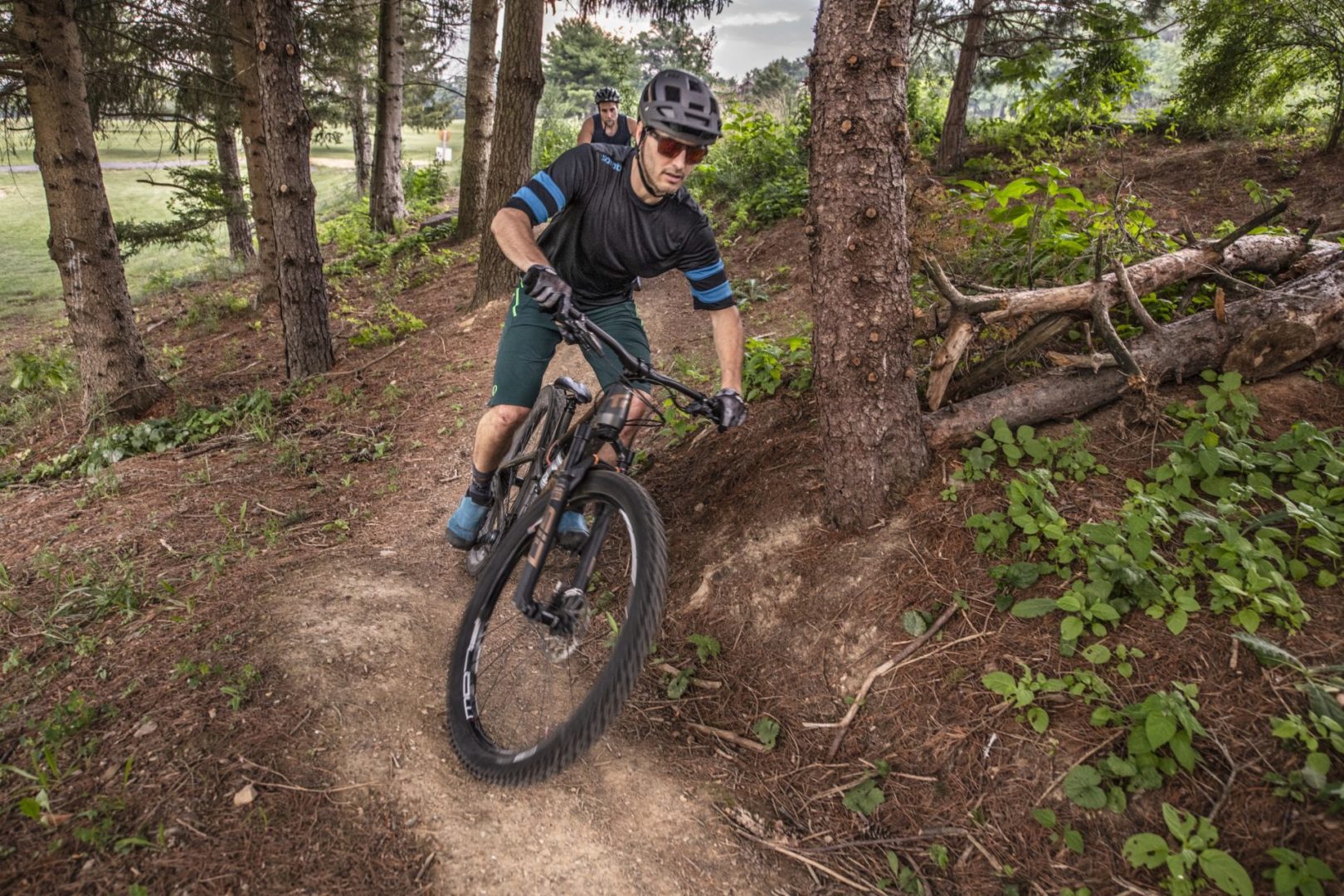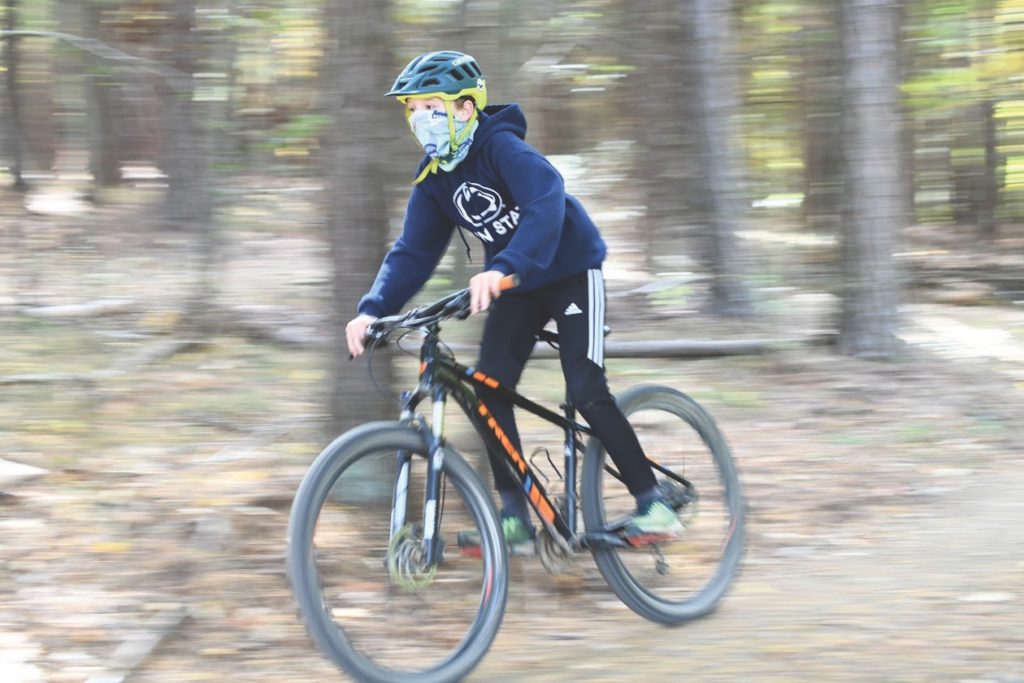
Ryan Leech, who has traveled the world for mountain bike competitions during a 20-year pro riding career, shows the authors the ropes of navigating the Harvest Fields Community Trails. Photo by Darren Andrew Weimert | Town&Gown

Ryan Leech, who has traveled the world for mountain bike competitions during a 20-year pro riding career, shows the authors the ropes of navigating the Harvest Fields Community Trails. Photo by Darren Andrew Weimert | Town&Gown
If you spend a lot of time out on the trails of central Pennsylvania like I do, you are bound to come across many a mountain biker. Rothrock State Forest has become a hotspot for the sport, drawing people from all over the state and beyond to our rough and rocky trails.
It amazing to see these two-wheeled riders out there, navigating over rock and root, up and down mountain trails that sweep in and out, as they tackle the treacherous landscape. I have always wanted to give it a go. Then I remember how difficult the trails can be to navigate by foot, and I decide to just keep on running and hiking.
“How do they do it?” I have often wondered as I see a mountain biker riding over a scattering of rocks that I have to carefully step over. But, my goodness, mountain biking sure does look like fun. I knew I just needed a place to learn how to do it.
Then, just last year, a new trail system was built out on the land owned by Calvary Church in Boalsburg right next to Rothrock, called Harvest Fields Community Trails. The church teamed with Nittany Mountain Biking Association and a slew of community sponsors to create the multi-use trail system that is perfect for learning the sport of mountain biking.
With flowing banked turns, fun bumps to ride up and over, and strategically placed rock piles, the machine-built trails were designed and built for riders to learn skills and confidence on two wheels. Riders new to the sport, as well as seasoned mountain bikers alike, have a place to call home at HFCT.
To get to know the trails and learn a little about how to navigate them, I asked a professional.
Ryan Leech has traveled all over the world competing in mountain bike competitions during his 20-year pro-riding career. Ryan teaches a skills clinic for adults new to the sport he loves so much, and he works with riders who are looking to advance their skills.

Ryan was nice enough to meet me at Harvest Fields, give me a quick tutorial and get me on the trails, because he knows what a great thing HFCT is for the area. When we met up on a humid July evening and looked out from the sweeping view of Happy Valley from the trail head, we could see a storm starting to form in the distance. We knew we weren’t going to have much time, so we got right too it.
Ryan started off with the basics, helping a newbie like me to become a confident and stable mountain biker.
“What that means is that your position on your bike is such that you are able to maintain your balance and be stable as you ride,” says Ryan, in the field near the trailhead where we went over a few drills before we tested the skill on the trail.
“There are two main positions for when you are coming up on an obstacle or riding down a hill, a neutral position and a ready-athletic position,” says Ryan as he demonstrates.
In the neutral position the rider is standing up out of the saddle in a natural, loose position. Peddles should be level, both raised up halfway.
The ready position is like being in an athletic stance on a bike, with knees wide, elbows out, chin forward.
“You are attacking, it is like you are ready. … You see a rock garden coming. This is where you want to be,” says Ryan. “This is all in the realm of bike-body separation, so to maintain your balance and stability, you need to separate your body from the bike, meaning you are not sitting and doing everything your bike is doing. So, if it hits a bump, it can move under you, rather than send you up.”

In the field we ran drills, putting ourselves in the neutral and ready positions, shifting our weight from front to back and to the left and right to maintain stability while riding. All of it was intuitive: You have to switch your weight on the bike to keep your balance depending on what you come across. While it may be somewhat natural, Ryan helped teach me the right technique so I could ride more confidently, efficiently, and safely.
“What you want to do is keep your weight equally balanced between your front wheel and your rear wheel for traction and for breaking,” says Ryan. He added, “When you see a little hill, you are going to naturally come forward because you want your center of mass to be over the center of the bike.”
Ryan was patient as we ran through the drills, giving me little hints that would help later when we hit the trail. When he felt like I was gaining confidence, it was time to do just that – and off we went.
From a distance, we could see the storm approaching faster, so we weren’t sure how much time we had to explore, but it was fun taking what I learned as we climbed 300 feet up a trail fittingly called Ascension. The climb up gradually meandered in and out and was not overly difficult, but I was working up a sweat in the humid air.
The wind was really picking up when we hit the top, and the sky was getting gray by that time. We had two trail options for our ride down, and we took a left down a path called DAsendit and away we went, hoping to beat the storm. Many of the HFCT are one way, so I didn’t have to worry about running into another biker as we sped down the mountain, but I had to keep my eyes focused on the trail to navigate the roller coaster ride of bumps and turns that make mountain biking such a great time.
“This is so much fun,” I yelled to Ryan halfway down. It is cliché, but I felt like a kid again, riding my bike at the local park. I tried to focus on the skills Ryan taught me, and it helped as I leaned into the embankments and kept my balance in the center of the bike. I didn’t wipe out once, not even a close call.
When we got back down to the Valley View Trail, I was having so much fun I was laughing. From that vantage point you get a sweeping view of Happy Valley, and we could see that storm was about ready to come pouring down any moment, so we raced back to our cars and would have to call it a day.
I was so grateful for that short ride, but I was disappointed that I didn’t get a chance to explore the rest of the trail system with Ryan. The good news is that the trails are open for the community to use, and I plan on coming back sometime soon to work on some of the skills Ryan taught me.
Even better yet, project leaders are currently in the middle of raising funds for phase two of the trail system, a mountain bike skills park, that will enable new riders to build confidence and skills on the trail. If they raise enough funds they hope to have construction start next spring and have the skills park opened in the summer.
“It is a place to build skills, really at all levels, whether it is Ryan Leech in skills clinics, or it is the local youth mountain biking team, or if the YMCA decides they want to run some camp out there, or Centre County Youth Service Bureau wants to run a program out there with Big Brothers/ Big Sisters, it is a place to allow people to go learn some of the basic skills,” said project leader Josh Stapleton.



When it comes to the Harvest Fields Community Trails, “community” is a word that really stands out. The trails came together with great community support to enhance the region. Josh is a converted road biker who was instrumental in making HFCT a reality. He says it has been huge success to see people out on the trails, having fun and learning a new sport the whole family can enjoy.
Besides offering monetary support, another just as important way people can be part of this community project is by volunteering to complete trail work. He said volunteers don’t need to make a huge commitment and are given support and instructions on how to help.
“It takes work to keep Harvest Fields awesome,” says Stapleton.
I can attest, they are awesome indeed. Now, get on your bikes and ride.
More information about HFCT can be found at nittanymba.org/harvestfields/.
To learn about becoming a leading supporter email [email protected]
To learn more about how you can get involved with helping to maintain HFCT (no experience required): [email protected]
This story appears in the August 2021 issue of Town&Gown.
Receive all the latest news and events right to your inbox.
403 S. Allen Street
State College, PA 16801
Phone: 814-238-5051
